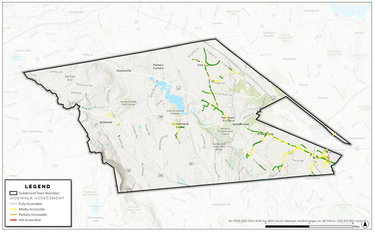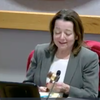How long should the town take to make all sidewalks accessible?
— Map from Town of Guilderland ADA Transition Plan
The analysis of sidewalk accessibility in Guilderland shows most sidewalks are fully accessible (green) or mostly accessible (yellow). McKownville has some sidewalks colored orange for partially accessible. Only 1 percent, or about a quarter of a mile, of Guilderland’s 30 miles of sidewalks are marked in red for being inaccessible.
GUILDERLAND — The town is poised to spend roughly $108,000 to comply with the federal Americans with Disabilities Act, making the public right-of-way accessible to everyone.
On Oct. 1, town board members heard a lengthy presentation from Chris Round, senior planner with LaBella, which studied Guilderland’s compliance, along with Carrie Ward, senior planner with the Capital Region Transportation Council.
Although the presentation on the transition plan was geared toward doing the upgrades over five years, Deputy Supervisor Christine Napierski advocated for completing the work sooner, and other board members agreed.
“My question is: Why five years? Because personally, I think that’s too long,” said Napierski.
She went on, “If we have a lot of sidewalks that are creating barriers for people in wheelchairs and scooters or maybe even just people who walk with a cane or a shuffle, which a lot of patients with Parkinson’s do, why are we waiting five years? I think we need to do it quicker than that.”
“It’s a big issue with the public,” agreed Councilman Gustavo Santos.
“I agree …,” said Councilwoman Amanda Beedle later in the discussion. “It’s now public record and they have a reference point,” she said of the places where repairs are needed.
The point of the analysis and transition plan is “to ensure that the Town of Guilderland pedestrian infrastructure in the public right-of-way is accessible for everyone, including people with disabilities,” the report says, as required by the federal government.
“We evaluated sidewalk panels, curb ramps, detectable warning strips …and then we looked at ped[estrian] crossings and also landing areas for transit stops,” Round told the board.
He went on, “The town is fortunate that almost 95 percent of the sidewalk facilities had a passing score …. Approximately 5 percent or nearly three-quarters of a mile of your sidewalk segments out of a total of nearly 30 miles did not have a passing score.”
The report shows that 55 percent or roughly 16 miles of Guilderland sidewalks are fully accessible and 42 percent or roughly 13 miles are mostly accessible while 2 percent or half a mile are partially accessible and 1 percent or about a quarter of a mile are not accessible.
The most common problem, about 20 percent, is because of heaving panels, followed by obstructions, missing panels, and being too narrow.
“Curb ramps,” said Round, “is another different story… Almost 42 percent of your curb ramps had a barrier or had a problem.” Curb ramps were not flush, did not have adequate width, or there was no detectable warning strip, Round said.
He went on, “We also looked at crosswalks and ped[edstrian] signals.” The activation device was checked for adequate height and the crosswalk for potholes.
Transit stops were also checked. “Transit stops are supposed to be connected to the sidewalk network,” said Round, noting they must be of “appropriate dimensions.”
The estimated cost for sidewalk compliance is $87,457.50; for curb ramps and signals is $80,600; and for crosswalks is $2,800 — for a grand total of $107,857.50.
McKownville
McKownville is “where the highest prevalence of barriers exist,” said Round.
The only two people who spoke at the Oct. 1 public hearing on the draft transition plan are both McKownville residents.
One of Guilderland’s oldest residential neighborhoods, McKownville, on the outskirts of Albany, has many of its streets lined with trees. In 2022, part of McKownville was placed on the National Register of Historic Places.
Ellen Manning, who heads the McKownville Improvement Association although she was not speaking in that capacity, said she is “kind of in limbo.”
Manning, who lives on Norwood Street, told the board, “It just isn’t clear to me whether my sidewalk really is in fact located on private property. If I am responsible for the cost of a new sidewalk, I hope the town will provide me with a list of contractors … I haven’t found anybody that seems to be responsible and is willing to do it.”
Supervisor Peter Barber responded, “I don’t think we’re going to make a distinction between whether it’s in the right-of-way or on private property. If it’s being used by the public, we’re going to try to repair it and bring it up to its ethical standards.”
He went on, “The only question might be, in order to maintain that, we may have to get an easement from you or some sort of dedication or ability to come on your property.”
Bill Kidd, who lives on Elmwood Street in McKownville, said he thought the plan had “an exceptionally optimistic view of the sidewalks.” He named several examples of heaves and missing panels not noted in the report.
“I would urge that a new look be taken to enhance the study before it is turned into a final draft,” said Kidd.
He also said it would be better to look at original deed maps to establish property lines rather than depending on satellite images. “I would be very surprised if any of the sidewalks fall in private property,” said Kidd, noting some of his research.
Kidd also told the board that, if the law does not allow it to make the roadside walks in McKownville public, “I urge you to change the law so that you can buy little bits of private property to make all the sidewalks public.”
Barber responded, “We need to take a look at surveys … Mr. Kidd may be 100-percent correct.”
Round noted that wasn’t in the scope of his work.
“The property lines you see on aerial imagery are not as accurate as a survey,” said the town’s planner Kenneth Kovalchik.
The public may submit written comments on the draft transition plan, which is posted to the town’s website, up until Oct. 11.
Shifting responsibilities
Barber said that the state’s Department of Transportation “is doing a lot of the work already” and has always been responsible for replacing pads. “I think it’s also true of curb ramps too,” he added.
“The town is responsible for repairing the curb ramp if it’s not functional,” said Round. “However, the DOT, if it is repairing the roadway, is obligated. So there’s this overlapping obligation.”
On the price of new sidewalks, Barber said, “It’s a lot of money. Take four steps, it’s $1,000.”
“There’s a huge cost difference between the highway department putting a sidewalk in or fixing a sidewalk versus Callanan,” said Kovalchik, of hiring an outside contractor.
Barber noted that, in his $46 million proposal for next year’s town budget, the responsibility of sidewalk maintenance is being shifted from the parks department to the highway department.
“We’re going to shift at the highway [department] by hiring more people because they already have the tools and the excavators and whatnot to actually work on the sidewalks,” Barber said.
“Our plan actually is to start building sidewalks,” Barber went on. “Usually, our sidewalks are built through grants or by contractors and by developers. But we’re going to start to do our own sidewalks, starting next year.”
“I believe the highway department only has enough forms maybe to do like 30 or 50 feet of sidewalk at a time,” said Kovalchik.
He also said, “I think it’s important for the board to understand we may never be 100 percent in compliance because what is compliant today, two years from now may not be so.”



